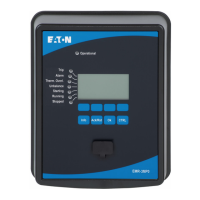under the condition that
I
e.heat
> SF ⋅ FLA
If the direct stator temperature measurements are available, the thermal replica model
will be modied to include the heat loss between stator and rotor. As a result, the motor
will be able to run longer under overload conditions. The heat loss serves as a cooling. At
some point, the cooling eect will cancel the heat increment so that the thermal capacity
used will reach some steady-state level that may be below the trip or alarm limit. This
equivalently raises the service factor and shifts the trip curve right.
If the thermal capacity used is held at a level that is below the trip threshold, the thermal
model will not trip. To prevent the protected equipment from overheating, the direct
temperature trip function must be enabled. Keep in mind that in order for the stator
temperature to be eective in the thermal replica model, the following conditions must be
met:
•
The RTD channels must be congured to measure the winding temperatures; and
• The Winding group trip function must be active:
[Protection Para / RTD / WD Group] »WD Trip Function« = “Active”
In addition, at least one of these winding temperatures must be valid.
Knowing the maximum steady stator temperature q
S
(°C), the thermal capacity used can
be estimated by the following formula:
TC
Used
% = (
q
S
240
+
I
eff.heat
2
⋅50
I
LR
2
⋅T
LR
)
when
I
e.heat
> I
TH
⋅ FLA
Stator Temperature Eect on Current Threshold Curve
Take, for example, I
LR
= 6 FLA, T
LR
= 15 s, and thermal trip level of 100%. The
relationship between the eective current threshold and the stator temperature can be
seen in the Stator Temperature Eect on Current Threshold Curve.
155www.eaton.comEMR-3MP0
4 Protective Elements
4.3 49 – Thermal Model

